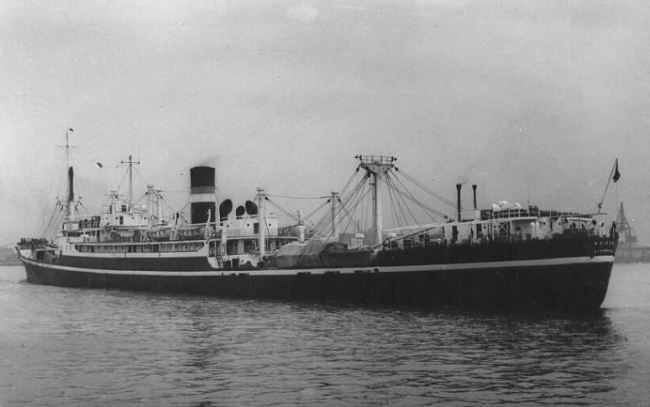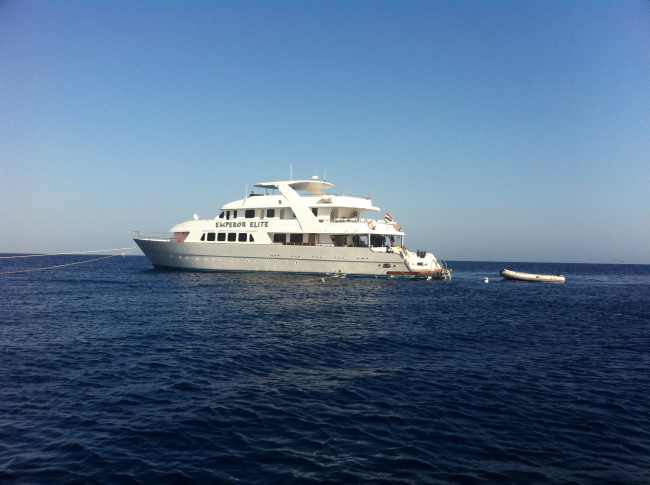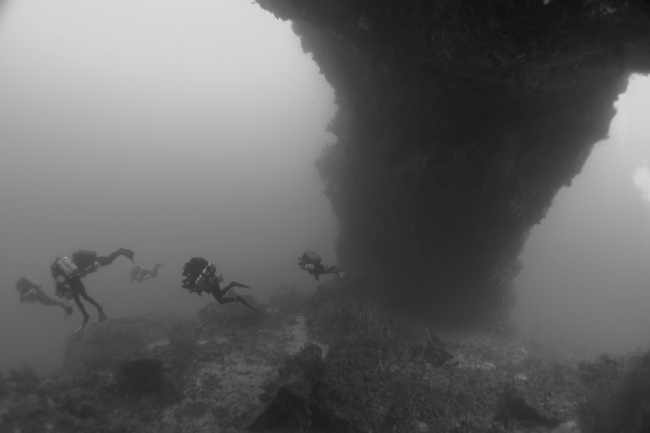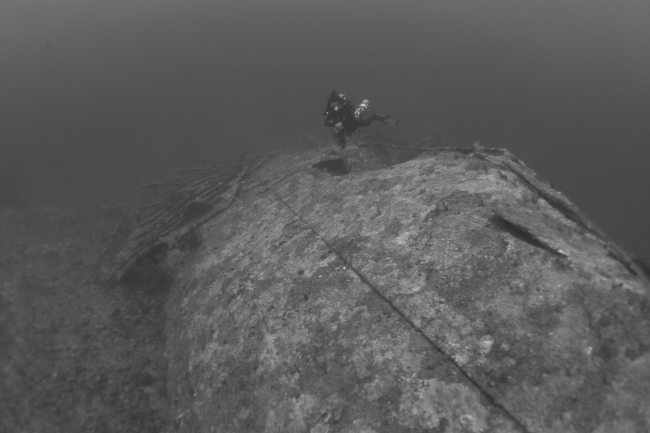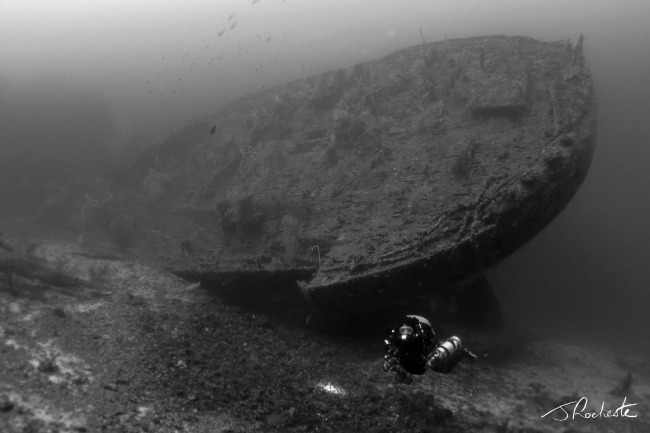So finally summer time arrived and our long awaited expedition to explore the wreck of the Maidan could begin.
The mission of the trip was to comprehensively map the wreck of the SS Maidan. Built by W Hamilton & Co, the Maidan was launched in March 1902 and officially described as Steel Screw Steamer. A very large ship for her day, She was 152.4m long, 17.7m wide and had a draught of 10m. The Maidan was owned and operated by T & J Brocklebank and had been used exclusively on the Eastern Trade routes, operating between European Ports and India. It was in 1923 that a navigational error resulted in the ship hitting the south side of the Rocky Island towards the southern end of the Red Sea.
The wreck was discovered a few years ago but due to its depth and remote location it has not been dived so much and as a result there is not much information available for an accurate description of its current condition and layout. There were a few pictures available on the web with a brief description but nothing in more detail. Hence, our expedition.
This trip is quite a unique expedition and run fairly in-frequently due to the experience level of the divers required. The shallowest part of the wreck is at 83m going down to a maximum depth of around 125m. It goes without saying that the trip is only available for Advanced Trimix divers. Realistically when diving to these depths the trip it is more geared at the Closed circuit rebreather divers. Open circuit divers can dive the wreck, and we in fact had two open circuit trimix divers on board, but the limitations of the gas that you can carry which has a direct affect on the bottom time possible becomes very apparent as does the gas bill for helium!
As a secondary mission we also planned to make a pit stop at the reef of Daedalus Reef to dive the wreck of the Zealot. The Zealot was a “spar decked double skinned iron hull screw steamship”. Originally named the Helme Park at John Readhead and Company, UK, for William Wright, an owner of numerous other merchant vessels. The ship was launched on 30 January 1873 with a length of 73 metres. Propulsion was provided by a compound steam engine which generated 120 horse power delivered to a single screw for a top speed of 12 knots. It was on the Zealot’s final voyage heading towards Bombay that it was once again a navigational error that led to its demise in either 1876 or 1887 (the exact date is still unclear)
Our floating luxury hotel for the week was provided by Emperor Divers in the form of their platinum boat called Emperor Elite of which we boarded in Port Ghalib marina, Marsa Alam. The 38m long wooden safari boat provided a spacious dive deck area for the multiple large cylinders of oxygen and helium on board, lots of tubs of sofnolime, as well as a twin piston booster pump and blending panel for custom mixing all desired gases.
After a local check dive to make sure all equipment and CCR units were functioning correctly we headed further afield to make our first decompression dive at the well known Marsa Alam reef of Elphinestone. Tucked underneath the southern plateau there is a spectacular feature that we refer to as the “Arch way”. It is a passage that can take you underneath the plateau from east to west or vice versa. Due to the large size of this passage way it looks like a giant archway on approach. The current on the day was fairly mild and so it was a nice gentle swim through the arch, but please note the current in this area can be quite strong and sometimes the arch way may not be advisable!
Once all divers we back on board we began our journey to Daedalus Reef. The weather conditions were perfect and it made for calm sailing into the night. Once the sun was up it was time to go and find the wreck and get the exact GPS coordinates so that all the divers could be dropped directly onto the wreck. The rough location of the wreck is no secret and not rocket science to figure it out when looking at the journey the ship was taking when it came to meet its end, however, to get the exact position takes a bit of experience and knowledge of the reef. Myself and Chris Armstrong were the ones to go to pin point the exact coordinates of the wreck. From my previous trips to the wreck and with a good current check in multiple places I managed to drop Chris into the water relatively close to the wreck and within 5 minutes he gave a pre agreed signal that he was now on the wreck. Perfect, with a handheld GPS with me in the zodiac we now had the exact coordinates ready to drop the divers.
The sea conditions were flat like a lake and the currents were pleasantly mild which made entry, descent and diving along the wreck nice and easy. Even though the current was mild you will still find that where the current hits the reef there will be what we call a split. A split is where the current will hit an obstacle and then go in two directions around that obstacle, in that area you will find very little current but more importantly you will also find pelagic marine life. Traditional here the pelagics will be in the form of Hammerhead Sharks. The divers were not disappointed. At a depth of around 65m during the descent some of the divers were lucky enough to have a group of 4 hammerheads swimming by them. The divers who were already on the wreck were also pleased to also have Hammerhead sighting. The wreck of the Zealot is quite broken up due to its impact to the reef with a debris field covering a wide area, lots to explore. There has been confusion in the past about whether this wreck is in fact the Zealot or if it was a different wreck called the Daccar. The Daccar was a passenger ferry, the Zealot was a cargo ship. Upon diving the wreck the guests were swimming past parts of locomotive and railway tracks which would definitely not be typical of a passenger ferry, plus the ferry would have been considerably larger than what was dived. Once all divers were up and all pictures analysed, it was concluded that the wreck on the reef in this area is for sure the Zealot as other people have previously stated. This means the Daccar is still to be found! That’s a mission for the next trip!
After a overnight sail travelling down south we eventually arrived at Rocky Island. The weather conditions were still very favourable for us and we were the only boat at Rocky Island. Because of the depth of the wreck, the long decompression times that were going to be done and the fact we were going to be there for a few days we put a permanent shot line directly to the wreck from our boat. This made it easy for descent (no reason for anybody not to find the wreck!), but more importantly it gave the divers easy access to emergency gases if required. We staged various extra bailout gases on this shot line from 40m and shallower, so if anybody had an issue they knew where to get gas from easily. We also then hung a deco station from this shot line. This would provide the divers who wanted to decompress on the line a little bit of extra space. Hang bars were located at 12m, 9m and 6m to spread the divers out.
Over the next three days at Rocky island are mission was achieved. The divers had some awesome dives exploring all parts of the wreck. Most CCR divers we diving with very rich helium mixtures to offset the potential narcosis so that they could enjoy the wreck and remember it afterwards! Dive times were on average between 3 – 4 hours! Good job the trip was in the summer time to make use out of the warmer water temperatures, and the bonus of no drysuits so people could pee freely! A huge, huge thanks to John Rochester for taking pictures from all over the wreck and his magical computer skills to piece those pictures together to give what I believe is the first ever photo of the wreck almost in its entirety.
Sadly it was then time to leave Rocky Island, say goodbye to the Maidan for now and begin the journey back to the north. The weather conditions still held out and we have a very smooth sail back up to Elphinestone reef. A brief pit stop was made for the chef to produce a massive spread of food and BBQ for all the guests (don’t worry it was an electric BBQ not one with real flames) After everybody was fed and watered we continued the journey.
We arrived at Elphinestone early in the morning for our final dive to hopefully, see some more sharks before the trip ended. Ephinestone did not disappoint. After exploring the southern arch of Elphinestone on the first day of the trip we now headed to the northern plateau to see what we could find. There was a current running across the plateau on descent but as soon as we down alongside we had the shelter to then swim further up towards the north. After only a short period of time a couple of Hammerheads came to say hello followed by two grey reef sharks circling in and out. A great end to a great trip.
Back on land it was then time to head to WonderBar (The best European bar in Port Ghalib marina) and reminisce on the trip, share diving stories and discuss who’s CCR unit is the best! He he he
Tekstreme would love to thank John and Janet Rochester for their drive to make this trip happen and for the fantastic photos from the trip. But of course we cannot forget Barry Woods, Chrissie Tyson, Dave Murphy, Dave Norton, Geoff Bridges, Shaun Fox, Norbert Miskolczi, Mel Ford and Ross Finlay for being a wonderful group of experienced divers to spend a week with. You are all more than welcome to come back and join us at any time.
Cat Braun – Tekstreme Technical Manager
The next big expedition being planned is a northern technical expedition to feature the wreck of the Yolanda in Ras Mohammed, and no we don’t mean to see the toilet seats!
The trip dates provisionally we are looking at is June 20th – 27th 2014.
For more information on this trip please contact us via our website at http://www.tekstremediving.com



